Our expert local tour guides will meet with you on your arrival at the Kotoka International Airport Accra, which is situated on the beautiful gold coast of Western Africa. Look out for the African Star Tours sign when you leave the main terminal building after passing through customs. Make yourself known to your guides who will be accompanying you for the duration of your time in Ghana and they will take care of you from here.
After boarding our vehicle, which will be your mode of transport for the duration of your tour, we transfer you to your accommodation which is situated in Accra. Once we have checked you in, our experienced guide will offer you Akwaaba (welcome) and brief you on all aspects of your trip. You can enjoy your evening meal at the hotel restaurant whilst acclimatising yourself to West Africa.
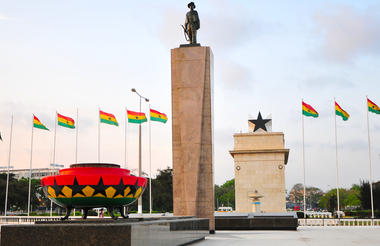
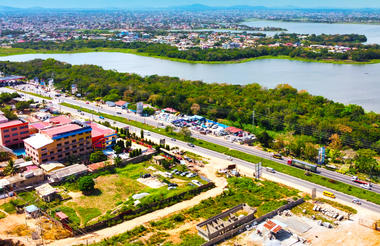
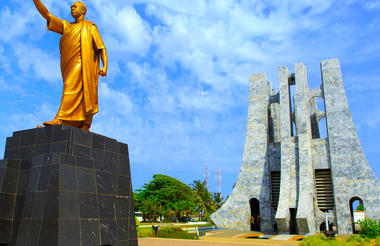
Economic districts, National Museum, James Town, Independence Square, Kwame Nkrumah Memorial Park, National Cultural Centre and Fantasy Coffins of Teshie and Nungua
Your first full day in Ghana, after breakfast at our hotel, we set off for our tour of Accra, passing through the economic and administrative districts on our way to the National Museum. Almost all the displays here are ethnographic in nature and the museum gives us an excellent overview of West African culture. The displays in the museum are not only from Ghana but most West African countries. There is an adjoining garden which is home to various sculptures which talk about West African tradition and customs and gives an overview of West African history. During our time here, we also get the chance to view and purchase some wonderful examples of traditional fabrics and crafts.
James town is next, we will enjoy a walking tour of this old community taking in some of the historical structures that predate the colonial era. The locals are committed to conserving these buildings and have made significant efforts to maintain them, our time here gives us an excellent idea of what it was like during the colonial era. The 30-meter-high lighthouse built by the British in 1871 and the attractive colorful fishing boats on the beach are also wonderful to see. We continue to Fort James that was built by the British as a trading post in 1673, before it joined the Dutch Fort Crêvecœur, and the Danish Fort Christiansborg. Fort James gave its name to the
Jamestown neighborhood in Accra. These areas give us a perfect picture of old Accra, distinguishing between British Accra and Dutch Accra. Of interest are the Brazilian stone houses, built by free enslaved African’s who reside in Brazil, they made their way back to Africa after the slave trade was abolished and their descendants have now integrated with the locals of James Town.
Lunch will be taken at a local restaurant (Country Kitchen) serving a selection of West African and continental dishes. In the afternoon we pass by Black Star Square which houses the independence monument and continue to Independence Square which is our main ceremony grounds and where we find the enclosed flame of African liberation, which was lit by Kwame Nkrumah himself in 1961. A short distance away we find the Kwame Nkrumah Memorial Park, final resting place of Ghana’s founder. Set in attractive gardens, there is an adjoining museum, which contains photos, artifacts and an insight into this incredible man’s life. The center was designed by a Ghanaian architect and built using Italian marble. Adjoining the park is the National Cultural Center, which is Ghana’s largest outdoor arts and crafts market where we find locals selling traditional crafts from all over West Africa. After testing your bargaining skills, we head to “Fantasy Coffins” of Teshie Nungua. Funeral and burial ceremonies in Ghana are very solemn occasions, but after the burial a celebration follows. Ghanaians believe that the departed move on into another world, the coffins made here may represent the occupation of the deceased or depict something that was important to them. There is all manner of coffin designs which one could be buried in from cars, cocoa pods, cigarette packets and airplanes to crocodiles, shoes, bottles of beer and boats. After an action packed first full day we return to our accommodation for our evening meal and to relax with the remainder of the evening free leisure time.
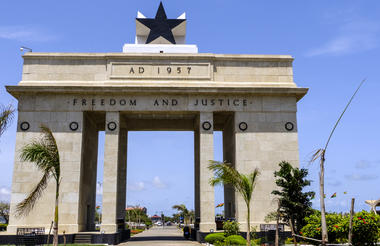
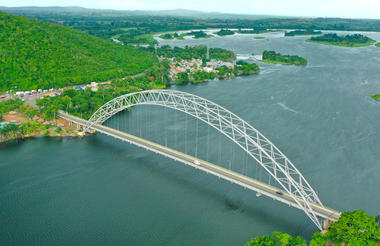
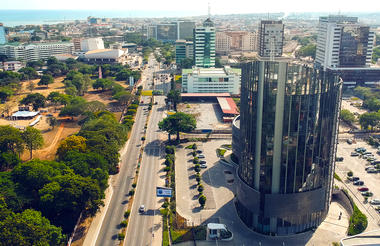
After breakfast we depart Accra and start our journey towards the Volt region of Ghana, passing over the magnificent Volta River on route. Before we head out of this bustling city we stop first at TK beads, experts in making beautiful traditional beads using ancient methods. Your guides will talk you through the skilled process of making the beads. Beads are culturally a symbol of wealth and beauty here in Ghana and are still used during traditional durbars and festivals. After the demonstration we can admire and buy a wide selection of beads that have been made here in the onsite shop.
Our next stop during our journey will be to visit the Shai Hills Reserve, an expanse of Savannah grassland and woodland dominated by large rock formations. large numbers of olive baboons, antelopes, green and spot nosed monkeys have been recorded in this protected area. Formerly the home of the Shai people who were ejected by the British in 1892, granite inselbergs dominate the landscape and house many active traditional shrines. We collect our wildlife guide and hike to the Obonu Tem caves searching for wildlife during our walk. There is a large colony of Egyptian Tomb Bats here not a common species to find in addition to wonderful colourful birds that include Turacos, Rollers and Bee-eaters. A wonderful morning at Shai Hills we then continue our journey towards the Volta region stopping at a hotel in Akosombo for our lunch. The hotel is situated in a perfect location on the banks of the Volta River overlooking this spectacular landscape. After lunch and only if time permits we will enjoy a short river cruise in local canoe enjoying the scenery as we head down river.
After our cruise we take a short tour of the Akosombo Dam, an amazing piece of engineering producing power for most of the country. This hydro-electric dam was built by Ghana’s first president Dr Kwame Nkrumah in 1965 and created what was then the largest manmade lake in the world. Today the Volta Lake is believed to be the third largest manmade lake in the world. An informative and interesting tour that offers excellent photographic opportunities of the outstanding views across this lake and habitat. We then continue our journey and transfer to our accommodation in Hohoe, the second largest city in the Volta region of Ghana.



A beautiful setting as we enjoy our breakfast before we set off for the Wli (Agumatsa) Falls found in the Agumatsa wildlife sanctuary in the Volta region of Ghana. The Wli Falls are believed to be the highest waterfall in West Africa, set in a beautiful location the surrounding flora and fauna make this an idyllic setting. On our arrival we will trek through the thick semi deciduous forest leading to the falls from Wli village. As we near the falls we can hear the enormous colony of Straw-coloured Fruit Bats found on the adjacent cliffs mixed with the powerful flow of the river. We can relax and enjoy a paddle in the pool beneath the waterfall which is safe for swimming if you are feeling adventurous, before setting off to the town of HoHoe for our lunch.
The afternoon is spent with the locals from the village of Tafi Atome, a wonderful community protecting a population of endangered True Mona monkeys. The community here perceives the Mona Monkeys to be sacred messengers from the gods and have been protecting the monkeys and their habitat for over 200 years. Quality time is dedicated here learning more about the history behind their protection from the local traditionalists during our time in the village. We venture into the surrounding forests to see these beautiful primates and during the walk our local guide will identify the many medicinal plants that grow here and explain how the locals use them to make traditional herbal remedies. The local ethnic group here are Ewe. A short distance from Tafi Atome we find the community of Tafi Abuife who have been weaving traditional Ewe kente cloth for generations. Kente cloth design here in the Volta Region of Ghana differs from the kente cloth found in the Ashanti Region at Bonwire. Colours and designs vary and during our time here we learn the history behind each design and how the community started producing this beautiful cloth. An ideal opportunity to purchase quality kente at very reasonable prices before we return to our accommodation to relax.



An early start as we check out of our hotel and set off Northwards towards the Ashanti Region of Ghana. Our journey today will take us into the beautiful Akuapem hills with outstanding views across Accra and Tema in the distance. At the top of the range we find the Aburi botanical gardens, set in a beautiful location that were founded by the British in 1890. The gardens are home to a wide variety of indigenous and exotic flora, offering outstanding views to Accra on a clear day. As we walk around the gardens our guide will identify the many trees and plants found here, some with medicinal properties and explain how they benefit the locals. A short distance from the gardens we find the relaxed and friendly Aburi craft village, where traditional African drums, sculptures and other crafts have been carved for generations. As we watch the skilled craftsmen at work it is worth noting that prices here are amongst the lowest in Ghana, making Aburi an ideal place to pick up some souvenirs. Your guide will talk you through the meaning and local beliefs connected to many of the sculptures that have been made the same way throughout history. Our lunch will be taken in Koforidua capital of the Eastern Region of Ghana before we continue our journey to Kumasi arriving in the early evening. Once we have checked into our accommodation we enjoy our evening meal with the remainder of the day free leisure time to relax.



A well-deserved relaxing breakfast this morning after our long journey yesterday. A day of culture and history awaits us as we set off on our city tour of Kumasi heading to the Manhyia Palace, home of the Asantehene King of the Ashanti’s and ruler of the powerful Asanteman Kingdom. The Palace Museum offers a fascinating excursion through the history of this powerful tribe and is extremely informative on the well documented Ashanti history and culture. Our tour gives us a firsthand insight into the legacies of the Ashanti’s and enables us to understand their culture during our time in this region. We continue to visit the National Cultural Centre. The cultural center is in one of the oldest suburbs of Kumasi near Bantama. There is a wonderful craft market here and during our leisurely tour we can visit the Prempeh II Jubilee museum which offers an excellent overview of Ashanti history and houses some wonderful ancient artifacts. A short distance from the palace is Kejetia market which is reported to be the largest outdoor market in West Africa. Visiting here gives us a wonderful opportunity to experience everyday life for the people in this great city and pick up a few bargain souvenirs. The market is a labyrinth of stalls nestled closely together, and a hive of activity. Some stall holders sleep here in the evenings as trade rarely stops. Lunch will be taken at a local restaurant which sells an excellent selection of local and continental dishes.
Our next stop is the Okomfo Anokye sword found at the Okomfo Anokye teaching hospital in Kumasi. Okomfo Anokye was a powerful priest born in 1600 in the Eastern Region of Ghana who helped the then Ashanti King Osei Tutu I to defeat the powerful Denkyera tribe. After defeating the Denkyera, legend has it the Golden Stool of Ashanti descended from the sky and landed on
Okomfo Anokye’s lap, which he gave to the Ashanti King. He then planted a sword into the ground as a symbol of unity between the Ashanti’s and Nzema tribes. The sword is still there to this day and has defied all human strength to pull it out. Prior to returning to our accommodation we visit the Kwame Nkrumah University of Science and Technology which was established by Ghana’s founding President Dr. Kwame Nkrumah in 1952. It is the leading university in the sub region for research into science and technology with students from all over West Africa studying here. Our evening we have the option of heading into the city to experience Kumasi night life where we can enjoy our evening meal and a live highlife band. If you are not feeling up to a late night you can choose to relax at your accommodation.
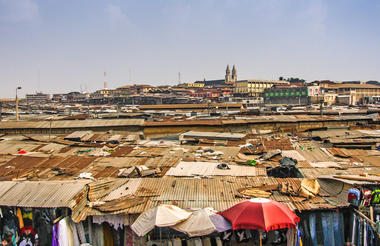
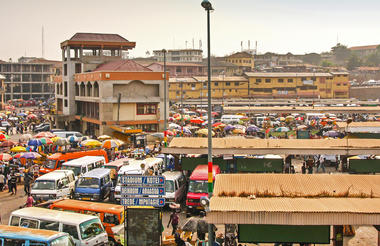
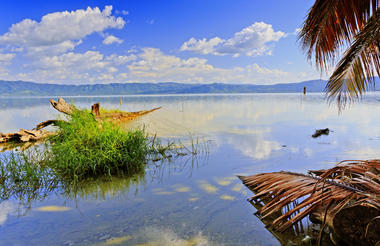
A morning visit to the last material remains of the great Asante Empire as we visit the traditional Asante buildings that are now recognized as World Heritage Sites by UNESCO. There are 10 active shrines within the buildings which are made from bamboo, timber and mud and thatched roofs. The walls are designed with motifs that have traditional symbolic meanings attached to ancient Adinkra symbols that we will learn more about later today. This is also where Nana Yaa Asantewaa, possibly the most important women in Ashanti history comes from, a great female warrior who led the Ashanti’s in the 1901 war against the British. Nana Yaa Asantewaa was also the Queen Mother of Ejisu Besease and we will visit the local spiritual shrine where she used to fortify herself before going into battle.
We continue our journey through Ashanti history by visiting the traditional villages of Adanwomasie and Ntonso. Our first stop is Adanwomasie, the birth place of Ghana’s rich colorful Kente cloth. Adanwomasi produces some of Ghana’s finest Kente cloth, many designs of cloth are woven here, and some are exclusive only to this region. Quality time is dedicated here as we walk through the community, interacting with the locals whose families have been weaving kente for generations playing an important role in the history of this beautiful cloth. During our time here, we learn about the history behind the many designs and see skilled weavers outside their homes still using traditional looms that have not changed in design for centuries.
The ancient village of Ntunso, is where adinkra cloth and symbols originate. These traditional symbols all have meanings and are carved from calabash shells. The adinkra symbols are then printed onto traditional cloth using natural dyes made from the bark of certain local trees. Adinkra cloth has been adorned by the Ashanti’s for more than 4 centuries and pre-dates kente cloth. Even today most Ashanti’s will wear adinkra cloth for funerals, festivals and other important occasions. During our time here, we can make our own strip of adinkra cloth using symbols with personal significance. After lunch we visit the village of Sokoban Krofrom where traditional brass casting has been the main source of income for the community for generations. A wide selection of items ranging from beads and jewelry to traditional statues are made here. The methods used to produce these wonderful brass works has not changed and during our time here we see a demonstration of the skilled process. After visiting some of the stores selling a wonderful selection in the village we return to our accommodation for our meal and to relax with the remainder of the evening being free leisure time.



This morning we take a leisurely breakfast before setting off Southwards to Elmina in the central region of Ghana. The town of Elmina was given its name by the Portuguese due to the abundance of Gold found in Ghana, translated Elmina means The Mine. Gold is of such importance to Ghana today and historically that we were even known as the Gold Coast before independence. Ghana’s gold is of the highest quality and we are the 8th largest exporter in the world and second largest exporter in Africa behind South Africa.
We stop at Assin Manso, an important town along the enslaved African trade routes. The town surrounds the Ndonkor Nsuo (Enslaved African River). This river is where enslaved Africans were checked for fitness and bathed before being transported to Cape Coast for shipment to the Americas. The slaves would have walked hundreds of kilometers from Northern Ghana through thick forests in shackles and chains, many being in poor health once they reached Assin Manso. Once bathed and rested the slaves would continue the final 32-mile march to the dungeons of Cape Coast Castle where they would remain for up to 6 weeks before being shipped to the Americas. In 1998, a symbolic gesture was made when the bodies of two free (previously enslaved) Africans, Samuel Carson from New York U.S.A and Crystal from Kingston Jamaica were returned to Cape Coast Castle and symbolically passed through the “Door of no Return” before being transported to Assin Manso for re-internment.
After our tour we continue to Cape Coast, we enjoy lunch upon arrival at a local restaurant overlooking the ocean before visiting the nearby Cape Coast castle which has been designated as a world heritage site by UNESCO. The castle is a thought provoking monument to a harrowing period in the region’s history. Quality time will be spent in the afternoon on an emotional journey touring this castle which held more enslaved Africans captive than any other in West Africa, viewing the dungeons and the infamous “Door of no return”. There is a historical museum inside, which explains the entire history of the castle and Cape Coast itself, as well as a souvenir shop selling literature on all of Ghana’s forts and castles, as well as the cultural history and traditions of Ghana. After a wonderful but thought-provoking day, we continue to check into our accommodation, enjoy dinner and relax.



An early start as we set off for Kakum National Park in the morning, after breakfast and Africa’s world-famous rainforest canopy walkway. This is a truly beautiful, tropical guinea rainforest and the canopy walkway is sure to be a highlight of your time in Cape Coast. This national park protects the original habitat that was found in this location and was the locals home and major source of food. The walkway consists of 7 bridges, attached to 7 emerging trees, 40 metres above the rainforest floor. Prepare to take a deep breath as you walk the suspended bridges. You will marvel at the outstanding views that stretch for miles across this breathtaking rainforest as you rest on the viewing platforms that are attached to the emerging trees between the bridges. We are sure you would agree that this is an exciting excursion never to be forgotten.
We return to the park headquarters where we find an excellent information center that offers a very informative overview of the parks flora and fauna. Over 40 different mammal species have been recorded within the park, which includes forest elephants, leopards and 6 primate species to mention just a few. As short distance from Kakum and on the border of the forest we find the International Stingless Bee Project. There have been approximately 9 species of stingless bees identified here in Ghana and their importance to our eco system is paramount. Our tour of the center teaches us about the importance of bees locally, their medicinal qualities and we get to see their hives, taste and buy quality stingless bee honey. There is a stingless bee walkway and butterfly garden where many of the forest butterfly species come to feed.
We stop for lunch at Han’s Cottage Botel near Kakum, Han’s is built over a lake containing Nile crocodiles and set in a beautiful location surrounded by tropical guinea rainforest. It is an original and comfortable establishment, which is teeming with bird life and an excellent place to enjoy lunch before setting off for Elmina. During our time in Elmina town we will visit the castle of St. George in Elmina. This is the oldest extant colonial building in sub Saharan Africa dating from 1482. This castle is steeped in history and played a prominent part during the tragic transatlantic enslaved African trade era. There is an informative museum inside which concentrates on local history and it is designated a world heritage site by UNESCO. Our final evening in the central region of Ghana can be spent at our accommodation or we can venture into town to experience nightlife for the locals.



A relaxing morning enjoying the facilities of our accommodation, maybe go for a swim, relax on the beach or just enjoy our final morning at this beautiful location. Prior to lunch we will freshen up and re-pack our bags, your local guide will collect them from your room and bring them to our vehicle to load. Before setting off back to Accra we enjoy our lunch overlooking the beautiful Gold Coast of West Africa. On route to Accra along the coastal road we find Fort Amsterdam in the town of Abandze. This is the first Fort built by the British between 1631 and 1638 and soon became the headquarters of English Gold Coast activities. In 1665 after a long and bloody battle the Dutch captured the fort and that is where it gets its name Fort Amsterdam. In 1811 locals loyal to the British from a neighboring community, Anomabo destroyed the fort, it was later restored to its former glory in 1951. It is believed that the first slave prison on the Gold Coast was in the hollow south east bastion of the fort. After an informative tour we continue our journey to Accra.
On arrival back in Ghana’s capital city we may have time to head to the Accra Mall to give you an insight into modern day Ghana. An opportunity to also purchase some last-minute souvenirs before heading home. Our early evening meal will be taken at a locally owned restaurant serving an excellent selection of local and international dishes which gives us an ideal opportunity to say our goodbyes and reflect on a wonderful time together. After your meal our team will transfer you to the airport for your departure - or we can arrange for you to stay an extra night in the capital if you would prefer.






